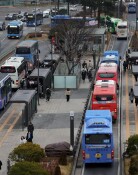Business Sentiment for Manufacturers, Still at Bottom-level
Business Sentiment for Manufacturers, Still at Bottom-level
Posted October. 08, 2004 22:58,
It turns out that while business sentiment in the manufacturing industry is still at its lowest point, exportation is also slowing down.
According to results of the Bank of Korea (BOK)s September business survey for some 2,491 enterprises reported on Friday, October 8, the business survey index (BSI) for the manufacturing industry was 72, maintaining the same level as of the previous month.
If the BSI is below 100 (baseline), enterprises with a negative business outlook will outnumber those with a positive outlook, and vice versa for above 100.
The BSI for Octobers business prospect was the same as in September with a figure of 79, and the dominant outlook was that business will not improve much in October.
The BSI for exportation increase rate lowered to 99 in September from 101 in August, falling below 100 for the first time since March.
This means that more enterprises answered that the exportation increase rate during September slumped rather than improving.
The BSI for the increasing rate of domestic sales fell from 82 in August to 80 in September, reflecting an increase in deterioration of domestic sales.
The BSI for the increase rate of sales lowered from 88 to 87. The index for large enterprises increased slightly from 97 to 99, but on the other hand, small and middle enterprises fell from 84 to 82, showing that the slump worsened in sales for small and middle enterprises.
The BSI showed that financial conditions fell to 80 from 81, and results showed that the monetary conditions for small- and mid-sized enterprises worsened.
Also, indices showing the production activity of enterprises, the BSI for production increase rate (90→91), increase rate in new orders (86→88), and operation rate (90→92), increased slightly from the previous month but was still below the baseline.
Meanwhile, the survey participants answered that the slump in domestic demands (31.3 percent), increase in raw material prices (22.3 percent), and uncertain economic situation (15.0 percent) were the bottlenecks in management.
Kang-Woon Lee kwoon90@donga.com







